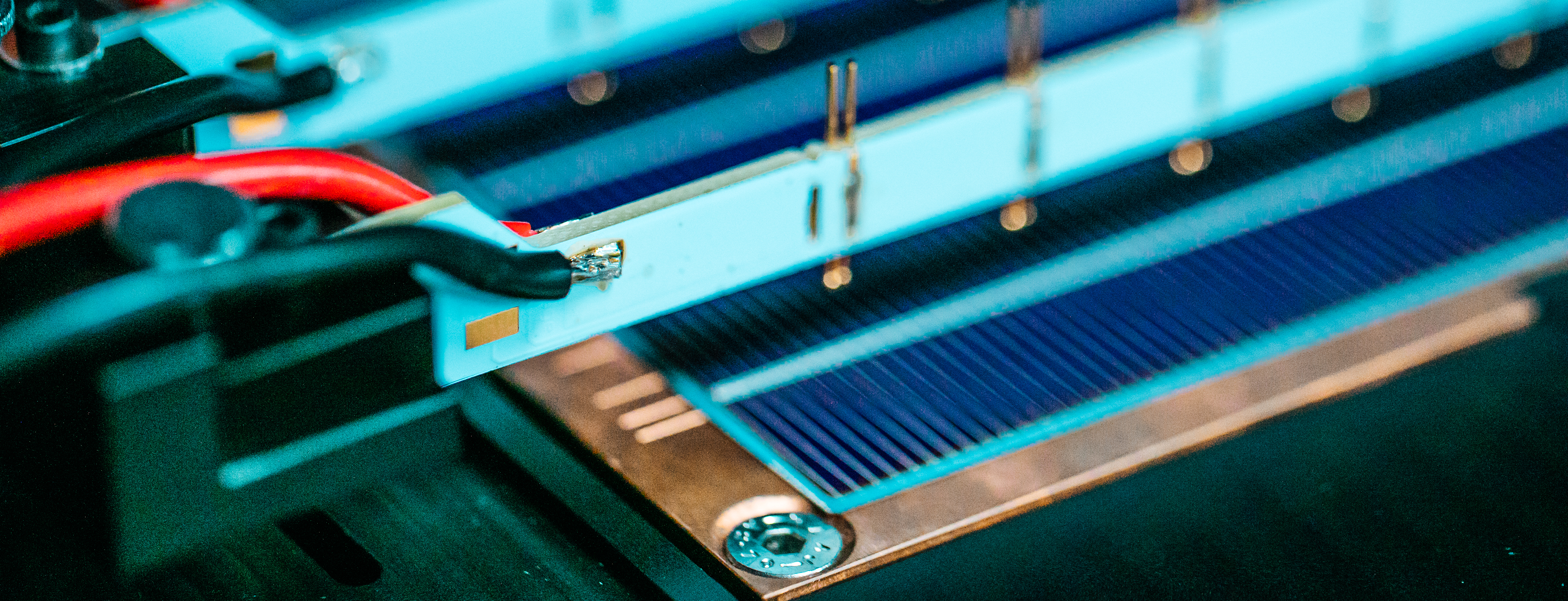

Michele De Bastiani and colleagues address the main challenges of bifacial perovskite/silicon tandem solar cells in their last perspective published in Joule. Bifacial tandems are a great innovation to combine stability and performance at once, bringing the perovskite technology one step closer to its commercialization.
This work, which came out in Science, demonstrates the first perovskite solar cells with 96% PCE retention after damp heat test, with PCEs 20%.
This work, which took place in ACS Energy Letters, reports the photoactivated p-doping of PTAA (widely used hole transport layer) to enhance hole extraction for (textured) perovskite/silicon tandem solar cells, making the device performance less sensitive to the variation of hole transport layer thickness.
This work, which took place in ACS Nano, introduces the scalability potential of the highly conductive MXene films and assesses their applicability as rear electrodes for silicon heterojunction solar cells.
Arsalan Razzaq and colleagues from KPV-Lab recently published their perspective in Joule, discussing the techno-economic barriers for the industrial adoption of silicon heterojunction technology. This work highlights critical areas that need to be addressed for enabling terawatt-scale silicon heterojunction deployment.
The review which is published in Nanophotonics focuses on light-trapping schemes for efficient photon recycling in perovskite solar cells (PSCs).
This study, which was recently published in Joule, reports a concurrent cationic and anionic perovskite defect passivation strategy using the phenformin hydrochloride molecule boosting the performance of monolithic perovskite/silicon tandem solar cells.
An analytical solution of photoluminescence reabsorption (PLr) is used to determine the intrinsic radiative carrier recombination rate of metal-halide perovskite films. Simulation of its impact on the quasi-Fermi-level splitting (QFSL) reveals it is detrimental at high but advantageous at low nonradiative recombination rates. Importantly, neglecting PLr results in overestimation of the effective nonradiative recombination rate in perovskite solar cells.
In this publication, which took place in Nature Energy, we investigate the influence of scattered and reflected light from the ground (albedo) on the performance of the bifacial tandems with different perovskite bandgaps.
This study, which came out in Joule, reveals that once the PCE approaches a practical upper limit, work on the control and mitigation of the module temperature can be equally or even more significant than costly marginal gains in PCE.
Our perspective on the Electrode Metallization for industrial scale Perovskite/Silicon Tandems is published now in Progress in Photovoltaics. The focus of the study reveals the challenges and opportunities of scaled metallization in terms of grid design to mitigate the power losses, adopting state-of-the-art screen-printed metallization as well as cost-effective alternate metallization routes and their viability for industrial applications.
Perovskite solar cells are an emerging photovoltaic technology that is gathering huge attention in the solar community for its power conversion efficiency. Recently, the coupling between the perovskite and the silicon technologies in the tandem configuration boosted even further this power conversion efficiency, reaching record values for terrestrial applications. However, several degradation mechanisms in the perovskite are negatively affecting the stability of this technology, questioning if successful commercialization is possible. At KPVLAB we are pioneering the outdoor testing of perovskite/silicon tandem solar cells to investigate, understand, and improve their stability.
This study, which takes place Advanced Materials Interfaces reports metallic lithium contact, applied to crystalline silicon solar cell and proved to be an excellent electron-selective, hole-blocking transport layer with an efficiency of 19%.
Ultrathin solar cells can be a path forward to low-cost photovoltaics due to their reduced material consumption and shorter required deposition times. With excellent surface passivation, such devices may feature higher open-circuit voltages (VOC). However, their short-circuit current density (JSC) may be reduced due to decreased light absorption. This mandates implementation of efficient light-trapping structures. To design efficient ultrathin solar cells that combine surface-passivation and light-trapping features, accurate 3-D modeling is necessary. To this end, we have developed a novel 3-D opto-electrical finite-element model to analyze the performance of ultrathin solar cells. We apply our model to the case of ultrathin (< 500 nm) chalcogenide solar cells (copper indium gallium (di) selenide, CIGSe), rear-passivated with nanostructured Al2O3 to circumvent optical and electrical losses, resulting in an absolute PCE enhancement of 3.9%, compared to cells without passivation structure.
This review, which took place in Advanced Materials, provides a comprehensive overview of the tin-oxide electron-selective layered for champion perovskite solar cells.
This study, published in Joule, reports 23.9%-efficient 6-in silicon heterojunction solar cells with improved damp-heat-stability for aiming the mass production.
This study, which develops a strategy to circumvent the problem of boron diffusion into the silicon, took place in the recent issue of Advanced Materials Interfaces. This study is the first publication KPV-LAB in the field of poly‐Si passivating contact solar cells.